Clinical Education 7: Reflection on Teaching Plan for HFMD, Perth
VerifiedAdded on 2022/10/04
|7
|1986
|16
Report
AI Summary
This report presents a detailed reflection on the development, presentation, and evaluation of a teaching plan designed to educate parents about Hand, Foot, and Mouth Disease (HFMD) in a clinical education setting. The student reintroduces the initial teaching plan, focusing on the learning context, learning needs, learner type, aims, and outcomes. The reflection delves into the experiences of developing the plan, including challenges with resource limitations and learner availability, while highlighting the importance of realistic goals and diverse teaching approaches. The presentation experience is analyzed, emphasizing the need for confidence and effective communication, and the use of PowerPoint slides. The student also reflects on observing peers' presentations, noting insights on concise slide design and time management. Overall, the report underscores the importance of educating parents on disease prevention, improving communication skills, and understanding audience needs for an effective teaching and learning experience. The Schön reflection model is used throughout the report.
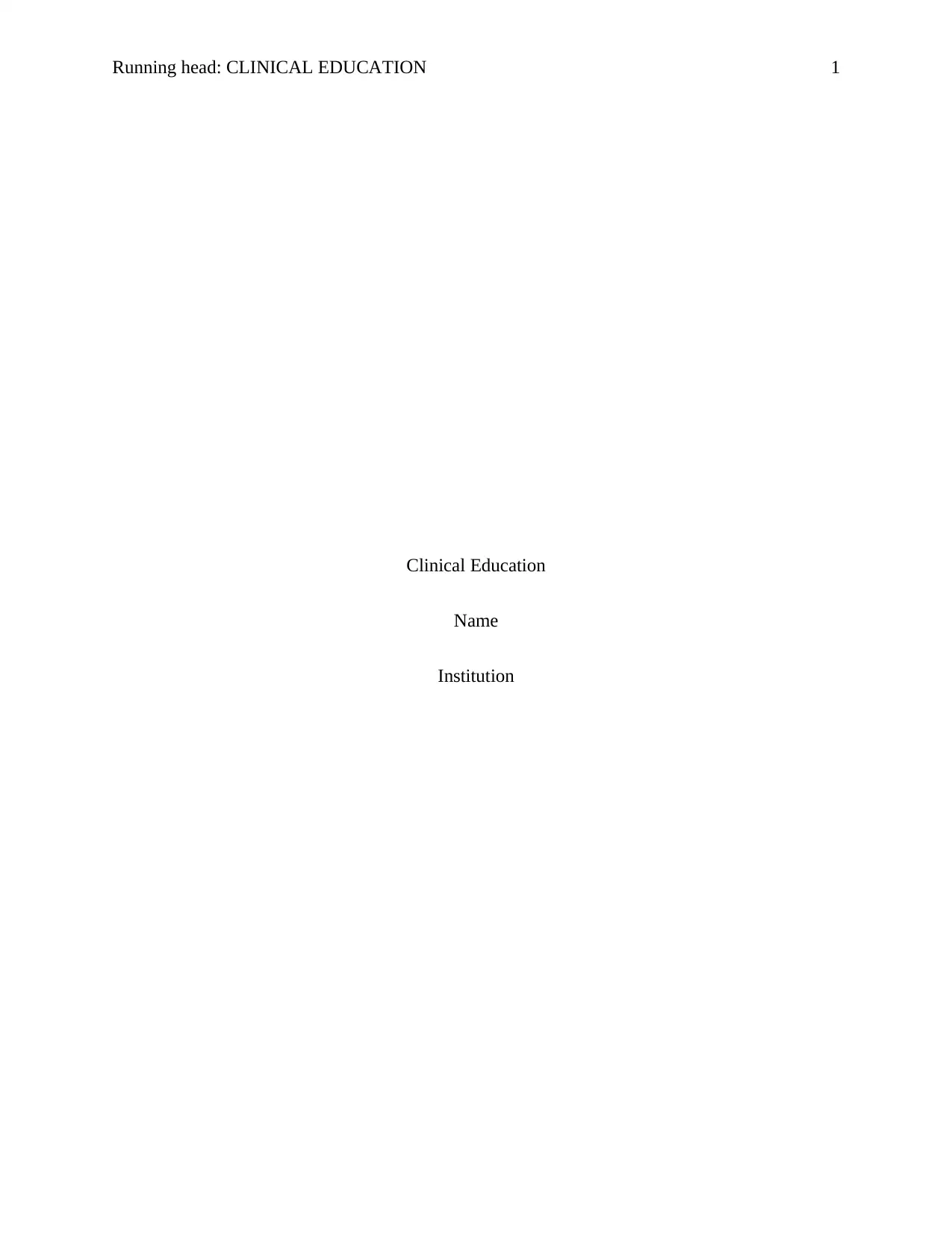
Running head: CLINICAL EDUCATION 1
Clinical Education
Name
Institution
Clinical Education
Name
Institution
Paraphrase This Document
Need a fresh take? Get an instant paraphrase of this document with our AI Paraphraser
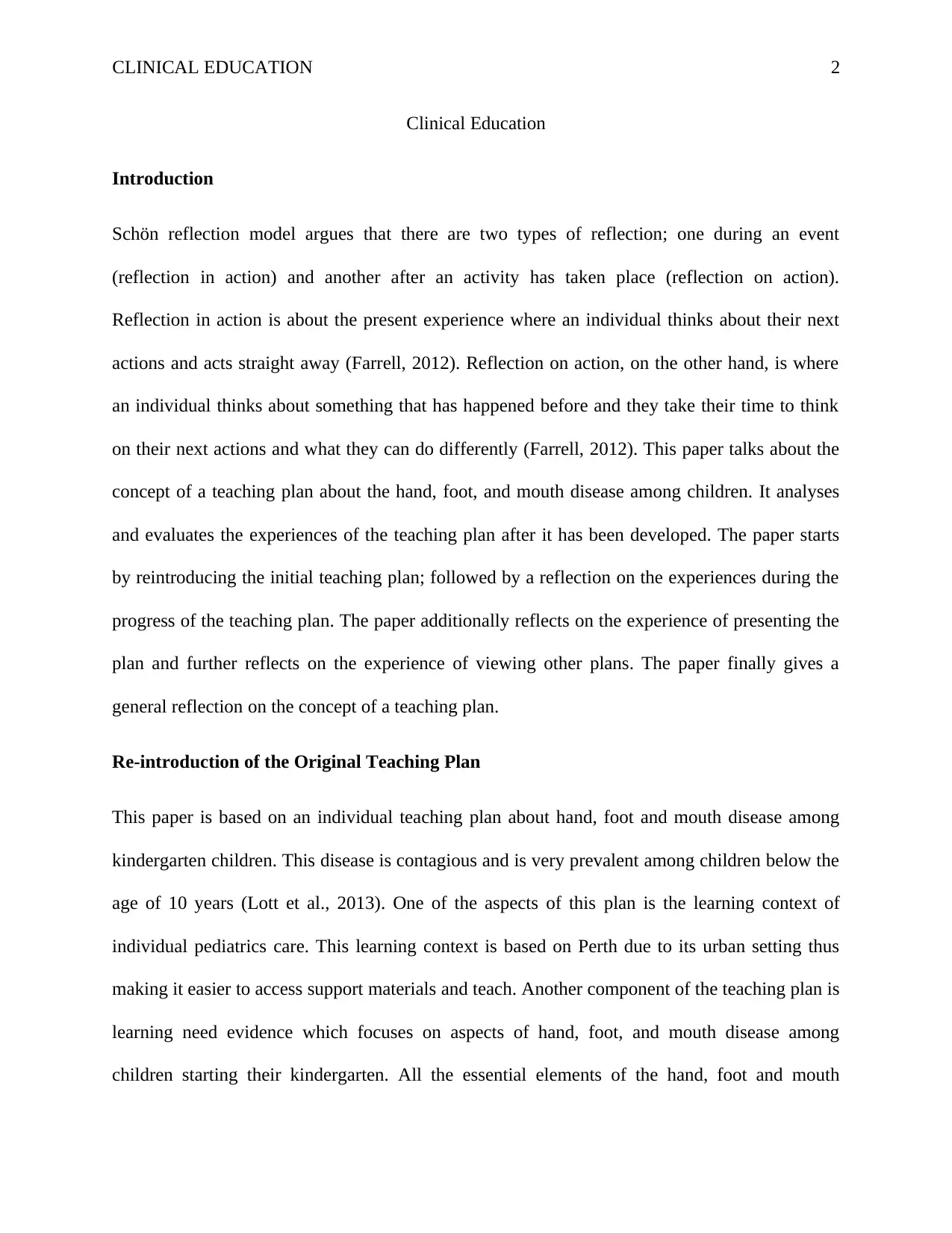
CLINICAL EDUCATION 2
Clinical Education
Introduction
Schön reflection model argues that there are two types of reflection; one during an event
(reflection in action) and another after an activity has taken place (reflection on action).
Reflection in action is about the present experience where an individual thinks about their next
actions and acts straight away (Farrell, 2012). Reflection on action, on the other hand, is where
an individual thinks about something that has happened before and they take their time to think
on their next actions and what they can do differently (Farrell, 2012). This paper talks about the
concept of a teaching plan about the hand, foot, and mouth disease among children. It analyses
and evaluates the experiences of the teaching plan after it has been developed. The paper starts
by reintroducing the initial teaching plan; followed by a reflection on the experiences during the
progress of the teaching plan. The paper additionally reflects on the experience of presenting the
plan and further reflects on the experience of viewing other plans. The paper finally gives a
general reflection on the concept of a teaching plan.
Re-introduction of the Original Teaching Plan
This paper is based on an individual teaching plan about hand, foot and mouth disease among
kindergarten children. This disease is contagious and is very prevalent among children below the
age of 10 years (Lott et al., 2013). One of the aspects of this plan is the learning context of
individual pediatrics care. This learning context is based on Perth due to its urban setting thus
making it easier to access support materials and teach. Another component of the teaching plan is
learning need evidence which focuses on aspects of hand, foot, and mouth disease among
children starting their kindergarten. All the essential elements of the hand, foot and mouth
Clinical Education
Introduction
Schön reflection model argues that there are two types of reflection; one during an event
(reflection in action) and another after an activity has taken place (reflection on action).
Reflection in action is about the present experience where an individual thinks about their next
actions and acts straight away (Farrell, 2012). Reflection on action, on the other hand, is where
an individual thinks about something that has happened before and they take their time to think
on their next actions and what they can do differently (Farrell, 2012). This paper talks about the
concept of a teaching plan about the hand, foot, and mouth disease among children. It analyses
and evaluates the experiences of the teaching plan after it has been developed. The paper starts
by reintroducing the initial teaching plan; followed by a reflection on the experiences during the
progress of the teaching plan. The paper additionally reflects on the experience of presenting the
plan and further reflects on the experience of viewing other plans. The paper finally gives a
general reflection on the concept of a teaching plan.
Re-introduction of the Original Teaching Plan
This paper is based on an individual teaching plan about hand, foot and mouth disease among
kindergarten children. This disease is contagious and is very prevalent among children below the
age of 10 years (Lott et al., 2013). One of the aspects of this plan is the learning context of
individual pediatrics care. This learning context is based on Perth due to its urban setting thus
making it easier to access support materials and teach. Another component of the teaching plan is
learning need evidence which focuses on aspects of hand, foot, and mouth disease among
children starting their kindergarten. All the essential elements of the hand, foot and mouth
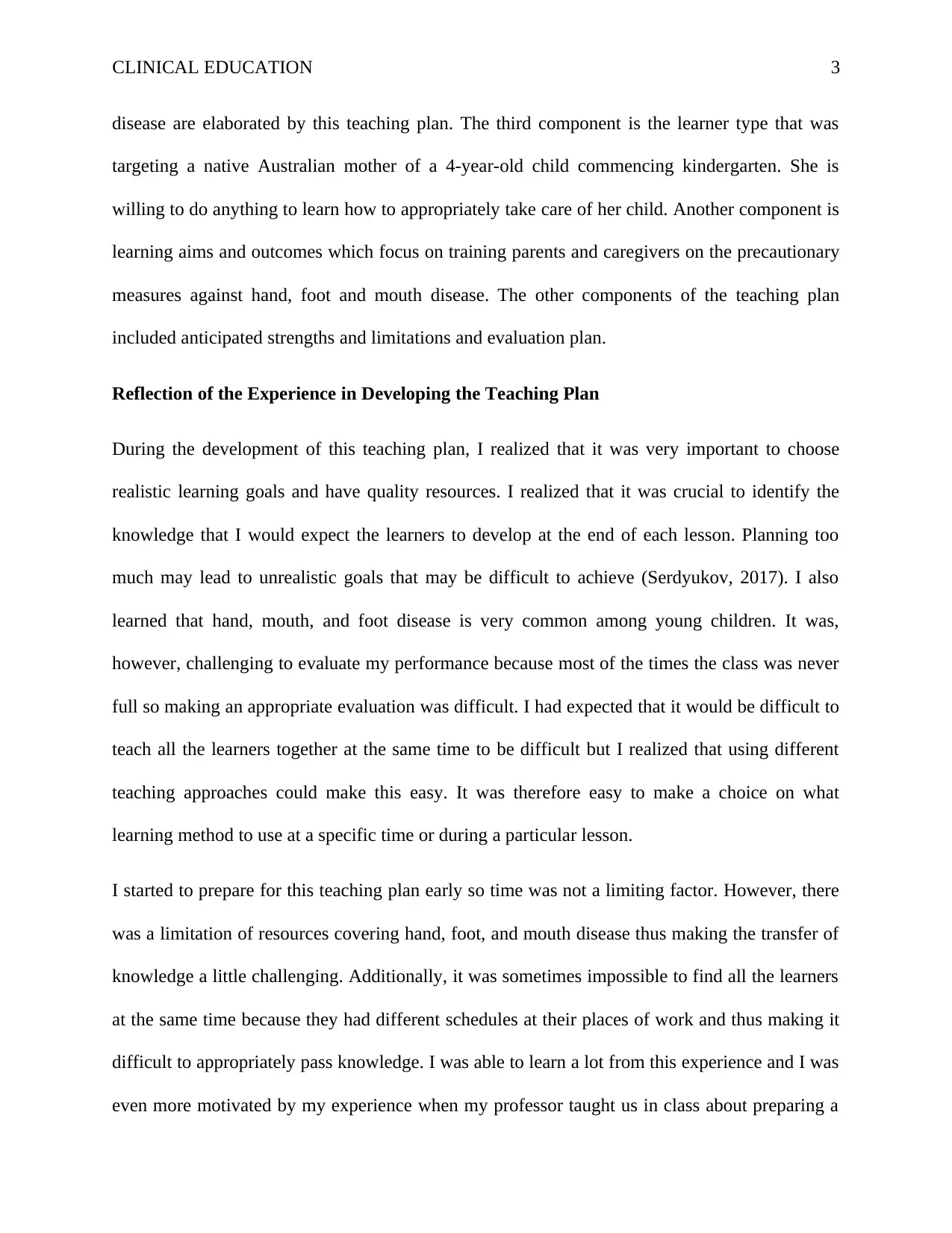
CLINICAL EDUCATION 3
disease are elaborated by this teaching plan. The third component is the learner type that was
targeting a native Australian mother of a 4-year-old child commencing kindergarten. She is
willing to do anything to learn how to appropriately take care of her child. Another component is
learning aims and outcomes which focus on training parents and caregivers on the precautionary
measures against hand, foot and mouth disease. The other components of the teaching plan
included anticipated strengths and limitations and evaluation plan.
Reflection of the Experience in Developing the Teaching Plan
During the development of this teaching plan, I realized that it was very important to choose
realistic learning goals and have quality resources. I realized that it was crucial to identify the
knowledge that I would expect the learners to develop at the end of each lesson. Planning too
much may lead to unrealistic goals that may be difficult to achieve (Serdyukov, 2017). I also
learned that hand, mouth, and foot disease is very common among young children. It was,
however, challenging to evaluate my performance because most of the times the class was never
full so making an appropriate evaluation was difficult. I had expected that it would be difficult to
teach all the learners together at the same time to be difficult but I realized that using different
teaching approaches could make this easy. It was therefore easy to make a choice on what
learning method to use at a specific time or during a particular lesson.
I started to prepare for this teaching plan early so time was not a limiting factor. However, there
was a limitation of resources covering hand, foot, and mouth disease thus making the transfer of
knowledge a little challenging. Additionally, it was sometimes impossible to find all the learners
at the same time because they had different schedules at their places of work and thus making it
difficult to appropriately pass knowledge. I was able to learn a lot from this experience and I was
even more motivated by my experience when my professor taught us in class about preparing a
disease are elaborated by this teaching plan. The third component is the learner type that was
targeting a native Australian mother of a 4-year-old child commencing kindergarten. She is
willing to do anything to learn how to appropriately take care of her child. Another component is
learning aims and outcomes which focus on training parents and caregivers on the precautionary
measures against hand, foot and mouth disease. The other components of the teaching plan
included anticipated strengths and limitations and evaluation plan.
Reflection of the Experience in Developing the Teaching Plan
During the development of this teaching plan, I realized that it was very important to choose
realistic learning goals and have quality resources. I realized that it was crucial to identify the
knowledge that I would expect the learners to develop at the end of each lesson. Planning too
much may lead to unrealistic goals that may be difficult to achieve (Serdyukov, 2017). I also
learned that hand, mouth, and foot disease is very common among young children. It was,
however, challenging to evaluate my performance because most of the times the class was never
full so making an appropriate evaluation was difficult. I had expected that it would be difficult to
teach all the learners together at the same time to be difficult but I realized that using different
teaching approaches could make this easy. It was therefore easy to make a choice on what
learning method to use at a specific time or during a particular lesson.
I started to prepare for this teaching plan early so time was not a limiting factor. However, there
was a limitation of resources covering hand, foot, and mouth disease thus making the transfer of
knowledge a little challenging. Additionally, it was sometimes impossible to find all the learners
at the same time because they had different schedules at their places of work and thus making it
difficult to appropriately pass knowledge. I was able to learn a lot from this experience and I was
even more motivated by my experience when my professor taught us in class about preparing a
⊘ This is a preview!⊘
Do you want full access?
Subscribe today to unlock all pages.

Trusted by 1+ million students worldwide
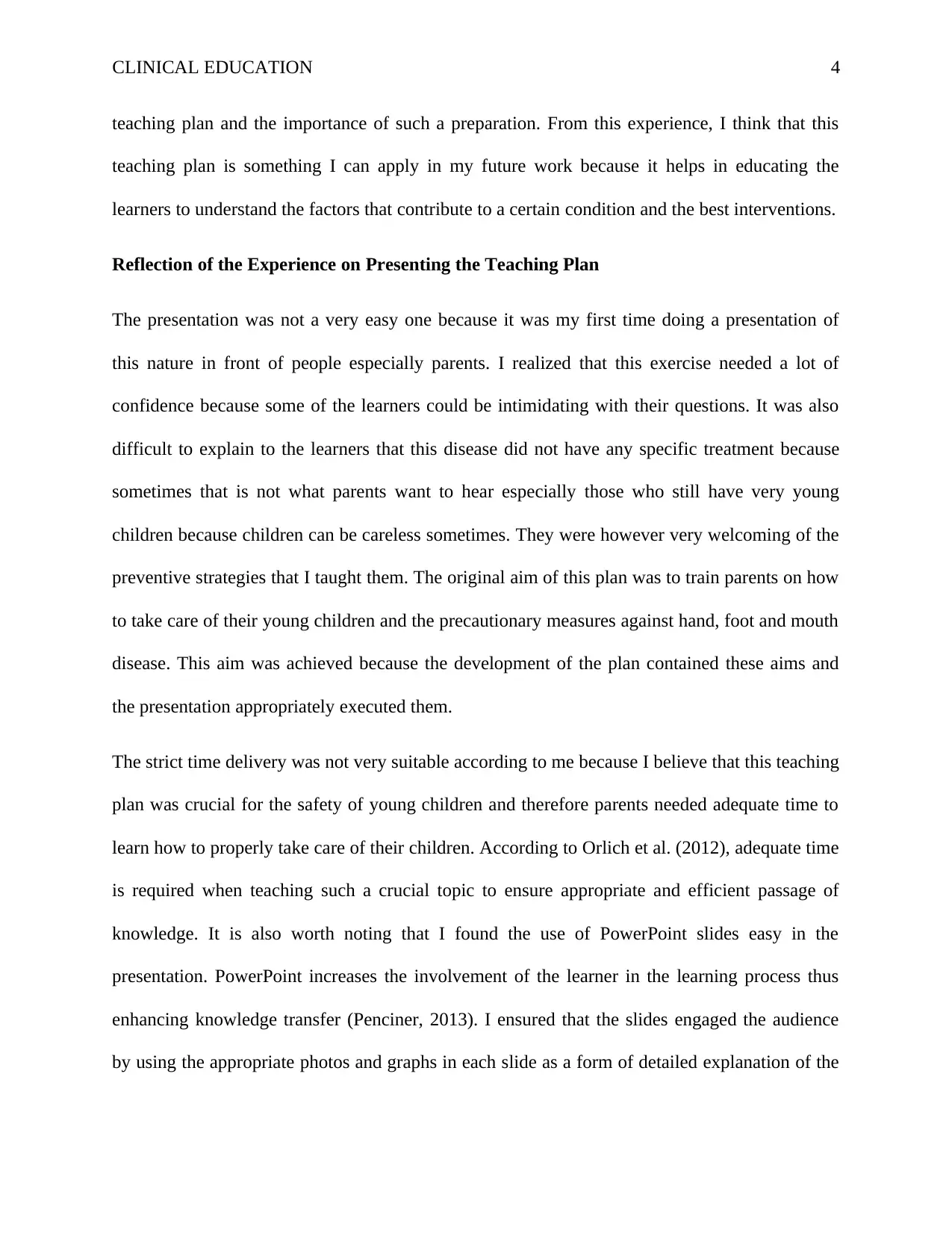
CLINICAL EDUCATION 4
teaching plan and the importance of such a preparation. From this experience, I think that this
teaching plan is something I can apply in my future work because it helps in educating the
learners to understand the factors that contribute to a certain condition and the best interventions.
Reflection of the Experience on Presenting the Teaching Plan
The presentation was not a very easy one because it was my first time doing a presentation of
this nature in front of people especially parents. I realized that this exercise needed a lot of
confidence because some of the learners could be intimidating with their questions. It was also
difficult to explain to the learners that this disease did not have any specific treatment because
sometimes that is not what parents want to hear especially those who still have very young
children because children can be careless sometimes. They were however very welcoming of the
preventive strategies that I taught them. The original aim of this plan was to train parents on how
to take care of their young children and the precautionary measures against hand, foot and mouth
disease. This aim was achieved because the development of the plan contained these aims and
the presentation appropriately executed them.
The strict time delivery was not very suitable according to me because I believe that this teaching
plan was crucial for the safety of young children and therefore parents needed adequate time to
learn how to properly take care of their children. According to Orlich et al. (2012), adequate time
is required when teaching such a crucial topic to ensure appropriate and efficient passage of
knowledge. It is also worth noting that I found the use of PowerPoint slides easy in the
presentation. PowerPoint increases the involvement of the learner in the learning process thus
enhancing knowledge transfer (Penciner, 2013). I ensured that the slides engaged the audience
by using the appropriate photos and graphs in each slide as a form of detailed explanation of the
teaching plan and the importance of such a preparation. From this experience, I think that this
teaching plan is something I can apply in my future work because it helps in educating the
learners to understand the factors that contribute to a certain condition and the best interventions.
Reflection of the Experience on Presenting the Teaching Plan
The presentation was not a very easy one because it was my first time doing a presentation of
this nature in front of people especially parents. I realized that this exercise needed a lot of
confidence because some of the learners could be intimidating with their questions. It was also
difficult to explain to the learners that this disease did not have any specific treatment because
sometimes that is not what parents want to hear especially those who still have very young
children because children can be careless sometimes. They were however very welcoming of the
preventive strategies that I taught them. The original aim of this plan was to train parents on how
to take care of their young children and the precautionary measures against hand, foot and mouth
disease. This aim was achieved because the development of the plan contained these aims and
the presentation appropriately executed them.
The strict time delivery was not very suitable according to me because I believe that this teaching
plan was crucial for the safety of young children and therefore parents needed adequate time to
learn how to properly take care of their children. According to Orlich et al. (2012), adequate time
is required when teaching such a crucial topic to ensure appropriate and efficient passage of
knowledge. It is also worth noting that I found the use of PowerPoint slides easy in the
presentation. PowerPoint increases the involvement of the learner in the learning process thus
enhancing knowledge transfer (Penciner, 2013). I ensured that the slides engaged the audience
by using the appropriate photos and graphs in each slide as a form of detailed explanation of the
Paraphrase This Document
Need a fresh take? Get an instant paraphrase of this document with our AI Paraphraser
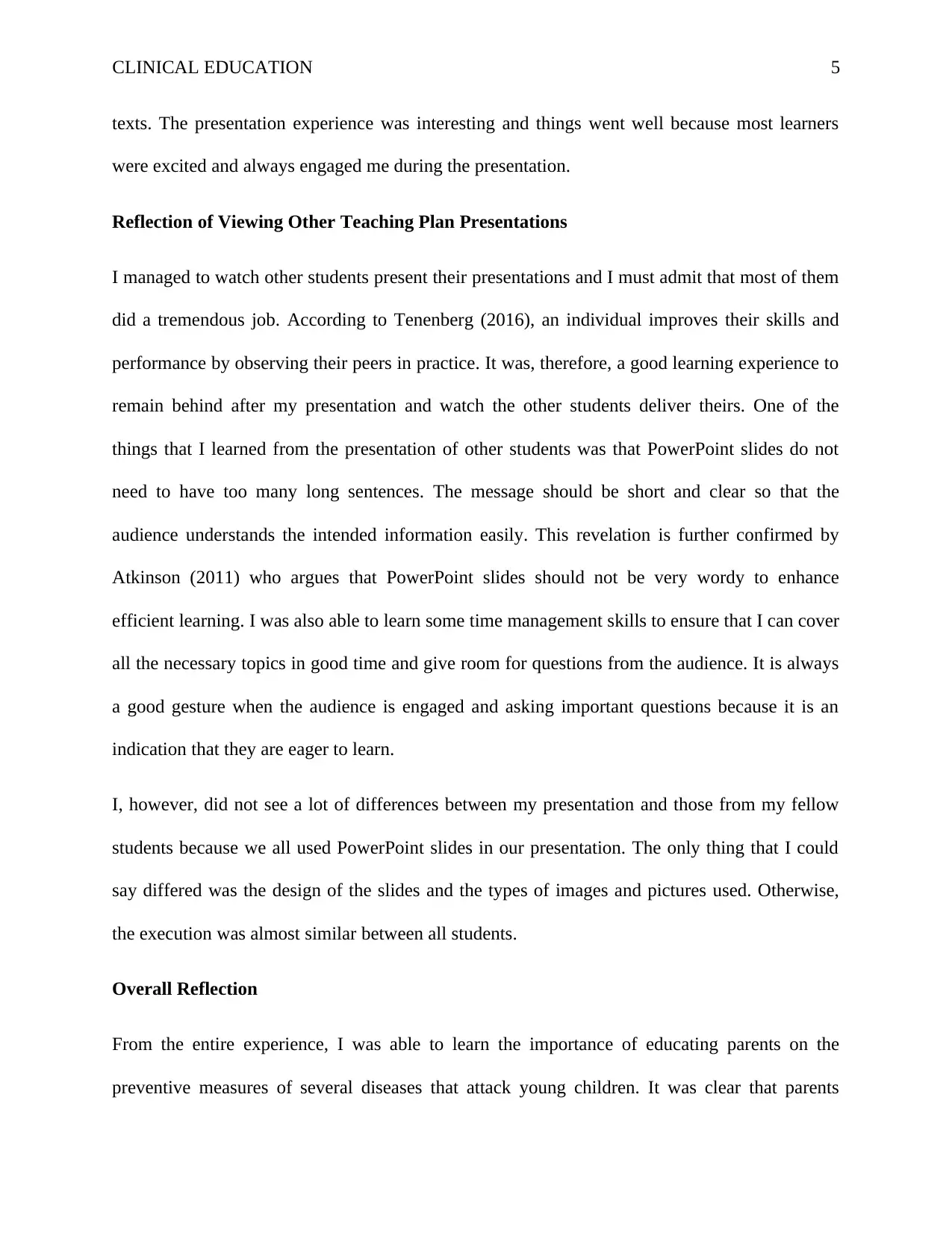
CLINICAL EDUCATION 5
texts. The presentation experience was interesting and things went well because most learners
were excited and always engaged me during the presentation.
Reflection of Viewing Other Teaching Plan Presentations
I managed to watch other students present their presentations and I must admit that most of them
did a tremendous job. According to Tenenberg (2016), an individual improves their skills and
performance by observing their peers in practice. It was, therefore, a good learning experience to
remain behind after my presentation and watch the other students deliver theirs. One of the
things that I learned from the presentation of other students was that PowerPoint slides do not
need to have too many long sentences. The message should be short and clear so that the
audience understands the intended information easily. This revelation is further confirmed by
Atkinson (2011) who argues that PowerPoint slides should not be very wordy to enhance
efficient learning. I was also able to learn some time management skills to ensure that I can cover
all the necessary topics in good time and give room for questions from the audience. It is always
a good gesture when the audience is engaged and asking important questions because it is an
indication that they are eager to learn.
I, however, did not see a lot of differences between my presentation and those from my fellow
students because we all used PowerPoint slides in our presentation. The only thing that I could
say differed was the design of the slides and the types of images and pictures used. Otherwise,
the execution was almost similar between all students.
Overall Reflection
From the entire experience, I was able to learn the importance of educating parents on the
preventive measures of several diseases that attack young children. It was clear that parents
texts. The presentation experience was interesting and things went well because most learners
were excited and always engaged me during the presentation.
Reflection of Viewing Other Teaching Plan Presentations
I managed to watch other students present their presentations and I must admit that most of them
did a tremendous job. According to Tenenberg (2016), an individual improves their skills and
performance by observing their peers in practice. It was, therefore, a good learning experience to
remain behind after my presentation and watch the other students deliver theirs. One of the
things that I learned from the presentation of other students was that PowerPoint slides do not
need to have too many long sentences. The message should be short and clear so that the
audience understands the intended information easily. This revelation is further confirmed by
Atkinson (2011) who argues that PowerPoint slides should not be very wordy to enhance
efficient learning. I was also able to learn some time management skills to ensure that I can cover
all the necessary topics in good time and give room for questions from the audience. It is always
a good gesture when the audience is engaged and asking important questions because it is an
indication that they are eager to learn.
I, however, did not see a lot of differences between my presentation and those from my fellow
students because we all used PowerPoint slides in our presentation. The only thing that I could
say differed was the design of the slides and the types of images and pictures used. Otherwise,
the execution was almost similar between all students.
Overall Reflection
From the entire experience, I was able to learn the importance of educating parents on the
preventive measures of several diseases that attack young children. It was clear that parents
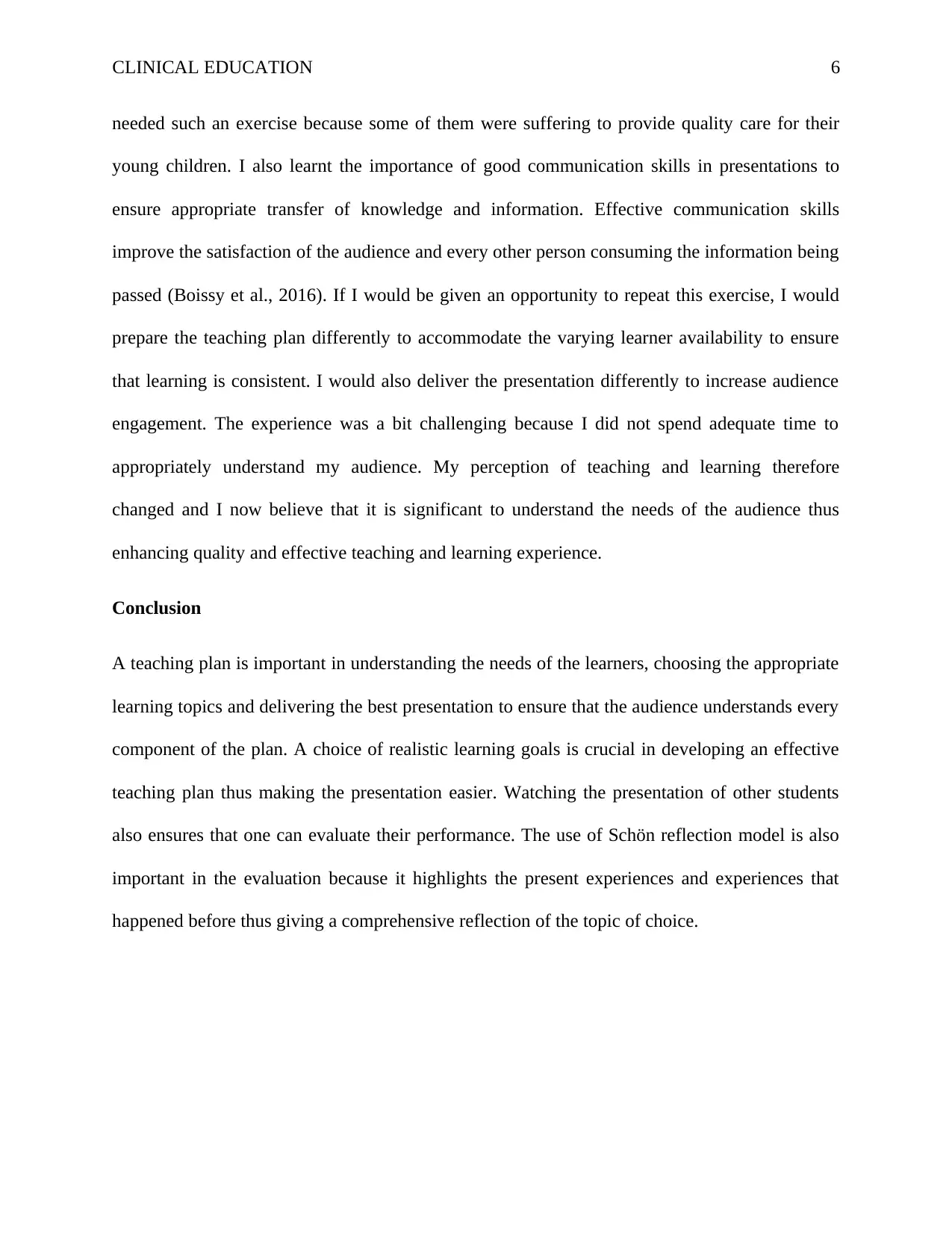
CLINICAL EDUCATION 6
needed such an exercise because some of them were suffering to provide quality care for their
young children. I also learnt the importance of good communication skills in presentations to
ensure appropriate transfer of knowledge and information. Effective communication skills
improve the satisfaction of the audience and every other person consuming the information being
passed (Boissy et al., 2016). If I would be given an opportunity to repeat this exercise, I would
prepare the teaching plan differently to accommodate the varying learner availability to ensure
that learning is consistent. I would also deliver the presentation differently to increase audience
engagement. The experience was a bit challenging because I did not spend adequate time to
appropriately understand my audience. My perception of teaching and learning therefore
changed and I now believe that it is significant to understand the needs of the audience thus
enhancing quality and effective teaching and learning experience.
Conclusion
A teaching plan is important in understanding the needs of the learners, choosing the appropriate
learning topics and delivering the best presentation to ensure that the audience understands every
component of the plan. A choice of realistic learning goals is crucial in developing an effective
teaching plan thus making the presentation easier. Watching the presentation of other students
also ensures that one can evaluate their performance. The use of Schön reflection model is also
important in the evaluation because it highlights the present experiences and experiences that
happened before thus giving a comprehensive reflection of the topic of choice.
needed such an exercise because some of them were suffering to provide quality care for their
young children. I also learnt the importance of good communication skills in presentations to
ensure appropriate transfer of knowledge and information. Effective communication skills
improve the satisfaction of the audience and every other person consuming the information being
passed (Boissy et al., 2016). If I would be given an opportunity to repeat this exercise, I would
prepare the teaching plan differently to accommodate the varying learner availability to ensure
that learning is consistent. I would also deliver the presentation differently to increase audience
engagement. The experience was a bit challenging because I did not spend adequate time to
appropriately understand my audience. My perception of teaching and learning therefore
changed and I now believe that it is significant to understand the needs of the audience thus
enhancing quality and effective teaching and learning experience.
Conclusion
A teaching plan is important in understanding the needs of the learners, choosing the appropriate
learning topics and delivering the best presentation to ensure that the audience understands every
component of the plan. A choice of realistic learning goals is crucial in developing an effective
teaching plan thus making the presentation easier. Watching the presentation of other students
also ensures that one can evaluate their performance. The use of Schön reflection model is also
important in the evaluation because it highlights the present experiences and experiences that
happened before thus giving a comprehensive reflection of the topic of choice.
⊘ This is a preview!⊘
Do you want full access?
Subscribe today to unlock all pages.

Trusted by 1+ million students worldwide
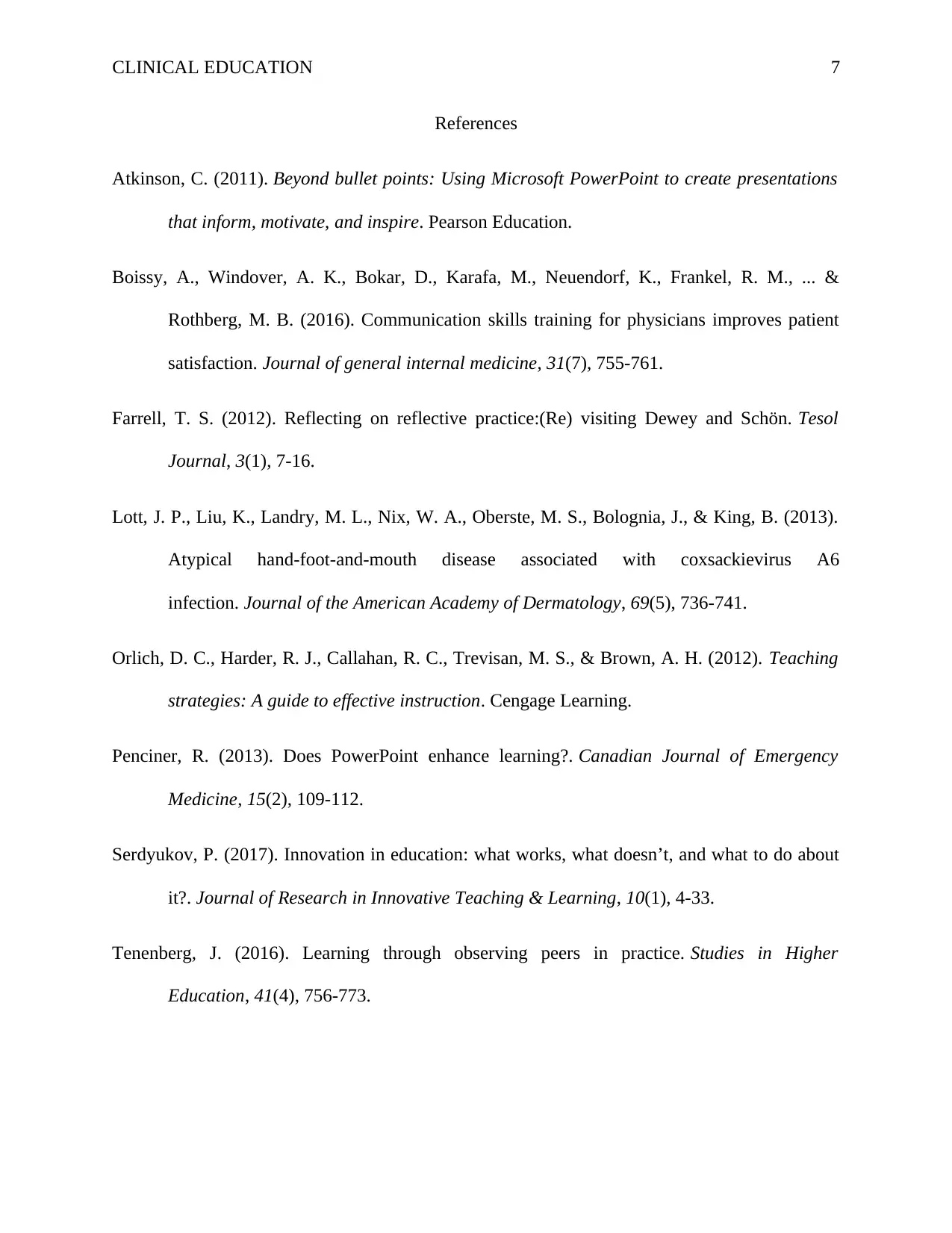
CLINICAL EDUCATION 7
References
Atkinson, C. (2011). Beyond bullet points: Using Microsoft PowerPoint to create presentations
that inform, motivate, and inspire. Pearson Education.
Boissy, A., Windover, A. K., Bokar, D., Karafa, M., Neuendorf, K., Frankel, R. M., ... &
Rothberg, M. B. (2016). Communication skills training for physicians improves patient
satisfaction. Journal of general internal medicine, 31(7), 755-761.
Farrell, T. S. (2012). Reflecting on reflective practice:(Re) visiting Dewey and Schön. Tesol
Journal, 3(1), 7-16.
Lott, J. P., Liu, K., Landry, M. L., Nix, W. A., Oberste, M. S., Bolognia, J., & King, B. (2013).
Atypical hand-foot-and-mouth disease associated with coxsackievirus A6
infection. Journal of the American Academy of Dermatology, 69(5), 736-741.
Orlich, D. C., Harder, R. J., Callahan, R. C., Trevisan, M. S., & Brown, A. H. (2012). Teaching
strategies: A guide to effective instruction. Cengage Learning.
Penciner, R. (2013). Does PowerPoint enhance learning?. Canadian Journal of Emergency
Medicine, 15(2), 109-112.
Serdyukov, P. (2017). Innovation in education: what works, what doesn’t, and what to do about
it?. Journal of Research in Innovative Teaching & Learning, 10(1), 4-33.
Tenenberg, J. (2016). Learning through observing peers in practice. Studies in Higher
Education, 41(4), 756-773.
References
Atkinson, C. (2011). Beyond bullet points: Using Microsoft PowerPoint to create presentations
that inform, motivate, and inspire. Pearson Education.
Boissy, A., Windover, A. K., Bokar, D., Karafa, M., Neuendorf, K., Frankel, R. M., ... &
Rothberg, M. B. (2016). Communication skills training for physicians improves patient
satisfaction. Journal of general internal medicine, 31(7), 755-761.
Farrell, T. S. (2012). Reflecting on reflective practice:(Re) visiting Dewey and Schön. Tesol
Journal, 3(1), 7-16.
Lott, J. P., Liu, K., Landry, M. L., Nix, W. A., Oberste, M. S., Bolognia, J., & King, B. (2013).
Atypical hand-foot-and-mouth disease associated with coxsackievirus A6
infection. Journal of the American Academy of Dermatology, 69(5), 736-741.
Orlich, D. C., Harder, R. J., Callahan, R. C., Trevisan, M. S., & Brown, A. H. (2012). Teaching
strategies: A guide to effective instruction. Cengage Learning.
Penciner, R. (2013). Does PowerPoint enhance learning?. Canadian Journal of Emergency
Medicine, 15(2), 109-112.
Serdyukov, P. (2017). Innovation in education: what works, what doesn’t, and what to do about
it?. Journal of Research in Innovative Teaching & Learning, 10(1), 4-33.
Tenenberg, J. (2016). Learning through observing peers in practice. Studies in Higher
Education, 41(4), 756-773.
1 out of 7
Related Documents
Your All-in-One AI-Powered Toolkit for Academic Success.
+13062052269
info@desklib.com
Available 24*7 on WhatsApp / Email
![[object Object]](/_next/static/media/star-bottom.7253800d.svg)
Unlock your academic potential
Copyright © 2020–2025 A2Z Services. All Rights Reserved. Developed and managed by ZUCOL.




